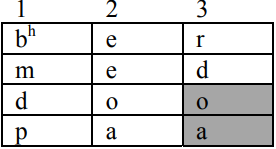


 Grammar
Grammar
 Tenses
Tenses
 Present
Present
 Past
Past
 Future
Future
 Parts Of Speech
Parts Of Speech
 Nouns
Nouns
 Verbs
Verbs
 Adverbs
Adverbs
 Adjectives
Adjectives
 Pronouns
Pronouns
 Pre Position
Pre Position
 Preposition by function
Preposition by function 
 Preposition by construction
Preposition by construction
 Conjunctions
Conjunctions
 Interjections
Interjections
 Grammar Rules
Grammar Rules
 Linguistics
Linguistics
 Semantics
Semantics
 Pragmatics
Pragmatics
 Reading Comprehension
Reading Comprehension|
Read More
Date: 28-2-2022
Date: 2024-01-20
Date: 24-2-2022
|
Reconstructing Proto-Indo-European sounds
One way we know this method is valid is that sometimes, unexpected discoveries confirm what began as surmises.
A. Languages have preferences in terms of how syllables are built. In Japanese, the only consonant that can occur at the end of a word is n. Otherwise, all words end in a vowel—arigatō, sushi, kamikaze, and so on. In Chinese, most words have just one syllable. In Proto-Indo-European, most words reconstructed have one vowel sandwiched between two consonants, such as the *bher-, “to bear”, or *med-, “to measure.”

B. But then there are Proto-Indo-European roots where instead of a final consonant, there is a first consonant, then a long vowel. A long vowel is marked with a macron: *dō- “to give,” *pā- “to protect.”

C. In the late 1800s, pioneering linguist Ferdinand de Saussure proposed that these words used to follow the normal consonant-vowel-consonant pattern, but that the vowels were now, as it were, stretching into a spot where there had once been a consonant.

Saussure assumed that the consonants must have been breathy ones pronounced back in the throat (such as h), given that sounds like this often make a vowel before them longer in languages around the world.

D. De Saussure’s theory was rejected because there was no concrete evidence that these sounds had existed. But early in the 20th century, ancient tablets written in cuneiform script were found in Turkey, dating as far back as the 1700s B.C. Many of them were written in what turned out to be an extinct Indo-European language, now called Hittite. Hittite has a consonant sound, written as an h, in some of the places where de Saussure guessed it would be.
E. Thus, today, Proto-Indo-European is assumed to have had these sounds, called laryngeals, although no living language preserves them.
|
|
|
|
"عادة ليلية" قد تكون المفتاح للوقاية من الخرف
|
|
|
|
|
|
|
ممتص الصدمات: طريقة عمله وأهميته وأبرز علامات تلفه
|
|
|
|
|
|
|
المجمع العلمي للقرآن الكريم يقيم جلسة حوارية لطلبة جامعة الكوفة
|
|
|